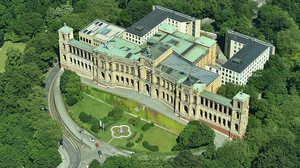The Maximilianeum – One name, three meanings
The "Maximilianeum" is a foundation, a building and the seat of the Bavarian State Parliament. The foundation stone for the Maximilianeum was laid in October 1857, and the building opened for use in 1874 after 17 years of construction work.
The Maximilianeum foundation
The Maximilianeum is now three different things. Firstly, it is an education foundation set up by King Max II in 1852, a model organisation that is unique in its field. The deed of foundation written by the king states that "the purpose of this institution is to complement the work of existing educational establishments. Any Bavarian, no matter what his estate, may enter this institution should he demonstrate the required capabilities. My people possess rare qualities of the mind and heart; they need only be given opportunity to develop them."
The Maximilianeum Foundation still works today to allow gifted secondary school leavers in the federal state (since 1980, girls as well as boys) to carry out their studies without financial concerns. Holders of the scholarship live in the Maximilianeum.
The Maximilianeum building
The second "Maximilianeum" is the building itself. Work on the building began in 1857 and was completed in 1874. The Maximilianeum is the impressive conclusion to Munich's Maximilianstrasse street – King Max II's own personal architectural monument. The historian Karl Alexander von Müller, who was himself once a scholar of the Foundation, gave his take on the Maximilianeum: "like the whole street, its structure was reminiscent of English Gothic, but its ornamentations, semicircular arches, small columns and niches with busts were bureaucratically conceived Renaissance. In its lofty position, under bright blue skies, it was nonetheless imposing."
On the subject of the King's favourite edifice, the historian Herbert Schindler wrote that "Munich is overlooked by its own acropolis, the Maximilianeum, a large public building on the banks of the Isar." For Max II, the Maximilianeum represented the beginning and end of his efforts to revolutionise architecture. The "Officer of the General Transport Directorate" (Generaldirektionsrat) and architect Friedrich Bürklein turned the King's dream into reality.
At the laying of the foundation stone, 200 singers sang "Max is building a home for Bavaria's promising sons." Max II did not live to see the completion of the building; work continued under his son Ludwig II.
Under the deed of foundation, the endowment included a gallery of 30 oil paintings and a collection of 24 marble busts of leading historical figures. The gallery was housed in three rooms (the Plenarsaal (plenary chamber), Senatssaal (senate room) and Steinerner Saal). The collection of historical paintings was intended to educate and edify both students and the people. Thirteen paintings were burned during the war in 1943. The remaining 17 are now housed in the Foundation, in the Neue Pinakothek and in the Bavarian Parliament.
To this day, the Foundation is also housed in the building, as is the building's owner.
The seat of the Bavarian State Parliament
In the new democracy created after the Second World War, the Bavarian State Parliament chose the Maximilianeum as its seat in 1949. Since then, the historic building has been adapted to the needs of a modern parliament with a series of remodelling projects and extensions.

